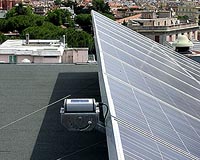 |
Santa Barbara, Calif. (UPI) Oct 19, 2009 U.S. scientists report a major advance in synthesizing photovoltaic organic polymers that convert sunlight into electricity in non-silicon-based solar cells. University of California-Santa Barbara Professor Guillermo Bazan and colleagues said they've been able to reduce reaction time by 99 percent, while more than tripling the average molecular weight of the polymers. The scientists said the reduced reaction time effectively cuts production time for the organic polymers by nearly 50 percent, since reaction time and purification time are approximately equal in the production process, in both laboratory and commercial environments. The higher molecular weight of the polymers increases current density in plastic solar cells by as much as a factor of more than four, a major benefit, the researchers said. The methodology "will greatly accelerate research in this area," Bazan said, "by making possible the rapid production of different batches of polymers for evaluation. "We plan to take advantage of this approach both to generate new materials that will increase solar cell efficiencies and operational lifetimes, and to reevaluate previously-considered polymer structures that should exhibit much higher performance than they showed initially." The research appears in the early online edition of the journal Nature Chemistry. Share This Article With Planet Earth
Related Links All About Solar Energy at SolarDaily.com
 More Efficient Solar Power With Space Technology
More Efficient Solar Power With Space TechnologyParis, France (SPX) Oct 19, 2009 A new system from an Italian company uses weather satellite data to estimate the potential of solar cell power plants and monitor their performance. The approach helps to give a faster return on investments in clean solar energy. Solar cells have been used for many years to power pocket calculators and, more recently, street signs, garden lighting and other small devices. But since ... read more |
|
| The content herein, unless otherwise known to be public domain, are Copyright 1995-2009 - SpaceDaily. AFP and UPI Wire Stories are copyright Agence France-Presse and United Press International. ESA Portal Reports are copyright European Space Agency. All NASA sourced material is public domain. Additional copyrights may apply in whole or part to other bona fide parties. Advertising does not imply endorsement,agreement or approval of any opinions, statements or information provided by SpaceDaily on any Web page published or hosted by SpaceDaily. Privacy Statement |